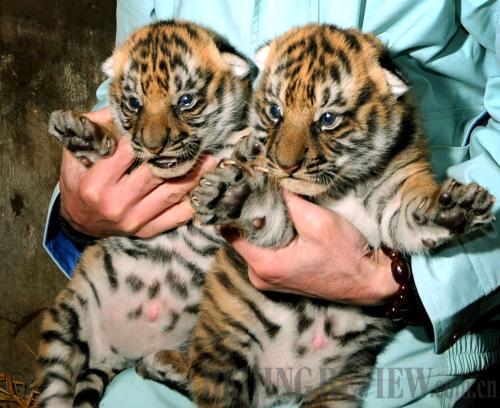|
 |
|
NEW MEMBERS: The twin South China tigers newly born in Shanghai Zoo in February are shown to the public (CFP) |
This year in the Chinese lunar calendar is the Year of the Tiger, ever regarded as the most regal of animals. But today they are being pushed to the brink of extinction.
The recent Top 10 Endangered Species established by the World Wildlife Fund for Nature (WWF) put the Bengal Tiger as No. 1 on its list.
"Last century, the number of tigers in the world range fell 95 percent. There are now only about 3,200 living tigers," said Diane Walkington, head of Species Program for the WWF. She said that the imperiled situation of tigers was caused by increasing human activity and illegal hunting.
Kingdom of tigers
China is one of the countries where tigers originated, and the home of the greatest number of subspecies in the world. They are the Siberian, South China, Indo-Chinese and Bengal. Previously there was also the extinct Caspian tiger.
Since ancient times, loving and worshiping tigers have been a cultural tradition among the Chinese. But with the development of human society, tigers in China have also been pushed to extinction. The trade of tiger-related products is one of the causes.
"Don't believe what illegal businessmen say about tiger bones having extraordinary medical values," said the action movie star Jackie Chan, at a press conference on February 5 for a film on the protection of tigers shot by WildAid, a non-profit organization which focuses on reducing demand for threatened and endangered species products and also increasing support for conservation.
Today, tiger farms have emerged around the world and their investors are trying to make trade of tiger-related products legal.
Dermot O'Gorman, a spokesperson for the WWF China Program Office, said if the trade in tiger-related products were allowed, it would stimulate the demand for them, even if the products were from farm-raised tigers. "Especially in a situation where we could not clearly distinguish between farm-raised or wild tiger products, their legalization for trade would provide illegal hunters and businessmen with chances to cover up criminal activity."
In 1988, China promulgated the Law on the Protection of Wildlife, listing tigers as a first-class protected species. In 1993, the Central Government completely banned the activities of purchasing, transporting, selling, using, importing and exporting and smuggling tiger-related products.
The habitat of tigers has become smaller. Compared to the early 1900s, their habitat area has decreased 96 percent and, correspondingly, the wild populations of tigers have dropped 97 percent.
Yin Hong, Vice Minister of the State Forestry Administration of China, said countries where the subspecies originated have primary responsibilities to protect wild tigers and their habitats.
An adult tiger basically needs 100 square km of natural wild area. "The tiger lies at the top of the food chain. It is an iconic species to guarantee and measure the health of an ecological system," Yin said.
China is promoting construction of tiger conservation zones and has been making great efforts to increase and develop habitats for tigers, she said. Since 2000, China has ploughed more than $70 billion into protecting natural forests, planting trees and returning farmland to forest and strengthening forest fire prevention and forest management, which has helped create greater habitat for wild tigers.
"As well, China has set up a protection network for tigers, consisting of natural conservation zones and protection stations," she said.
"Since the early 1980s, in order to save tigers and recover and rebuild wild tiger species, China has developed domestication and reproduction techniques and adopted strict measures to strengthen tiger management," said Yin, adding that China has also taken measures to improve public awareness about the protection of tigers.
The Chinese Government also cooperates with the World Bank and non-governmental organizations to carry out a program to reform the forestry management so as to expand the area of natural reserve and realize coexistence between tiger groups and other wildlife.
On February 12, the Beijing Genomics Institute (BGI) and its collaborators announced the International Big Cats Genome Project in Shenzhen, which plans to complete the sequencing and assembling of lion, tiger and leopard genomes within a year and explore the applications of genome sequencing technology in studies of animal behavior, conservation biology and other disciplines and fields.
Experts said the information about tiger genomics will have far-reaching significance in many related scientific fields. It would provide genetic evidence to enable better understanding of important species, and new and important models for qualitative and quantitative understanding of interaction between the environment and genetic factors.
Besides comparative genomics research of the family of felines, study of the hybrid offspring of tigers and lions is an ideal model to study crossbreeding. BGI plans to launch tigons (a cross between male tigers and female lions) and ligers (a cross between male lions and female tigers) genome and epigenome projects once the genomes have been decoded. The deciphered information will provide an opportunity to re-explain the definition of "hybrid" and "species" from the aspect of DNA sequencing and chromatin variation.
| 